Holmes Institute: HI5017 Managerial Accounting Assignment Report
VerifiedAdded on 2022/08/22
|17
|3940
|26
Report
AI Summary
This report delves into the realm of managerial accounting, focusing on the critical analysis of standard and target costing techniques. It begins with an introduction to managerial accounting tools, emphasizing their role in strategic decision-making and cost management within organizations. The report then explores the features and importance of standard costing, highlighting its use in budgeting, inventory costing, and product pricing. It analyzes an article discussing the application of standard costing in the Turkish automotive industry, showcasing its relevance in contemporary manufacturing. The report then transitions to target costing, explaining its focus on product life-cycle costs and market-driven pricing. It compares and contrasts standard costing and target costing, emphasizing their respective strengths and weaknesses. The report concludes by offering recommendations on which costing system is most suitable for planning and control purposes in modern organizations, providing a comprehensive overview of the practical applications and strategic implications of both costing methods.
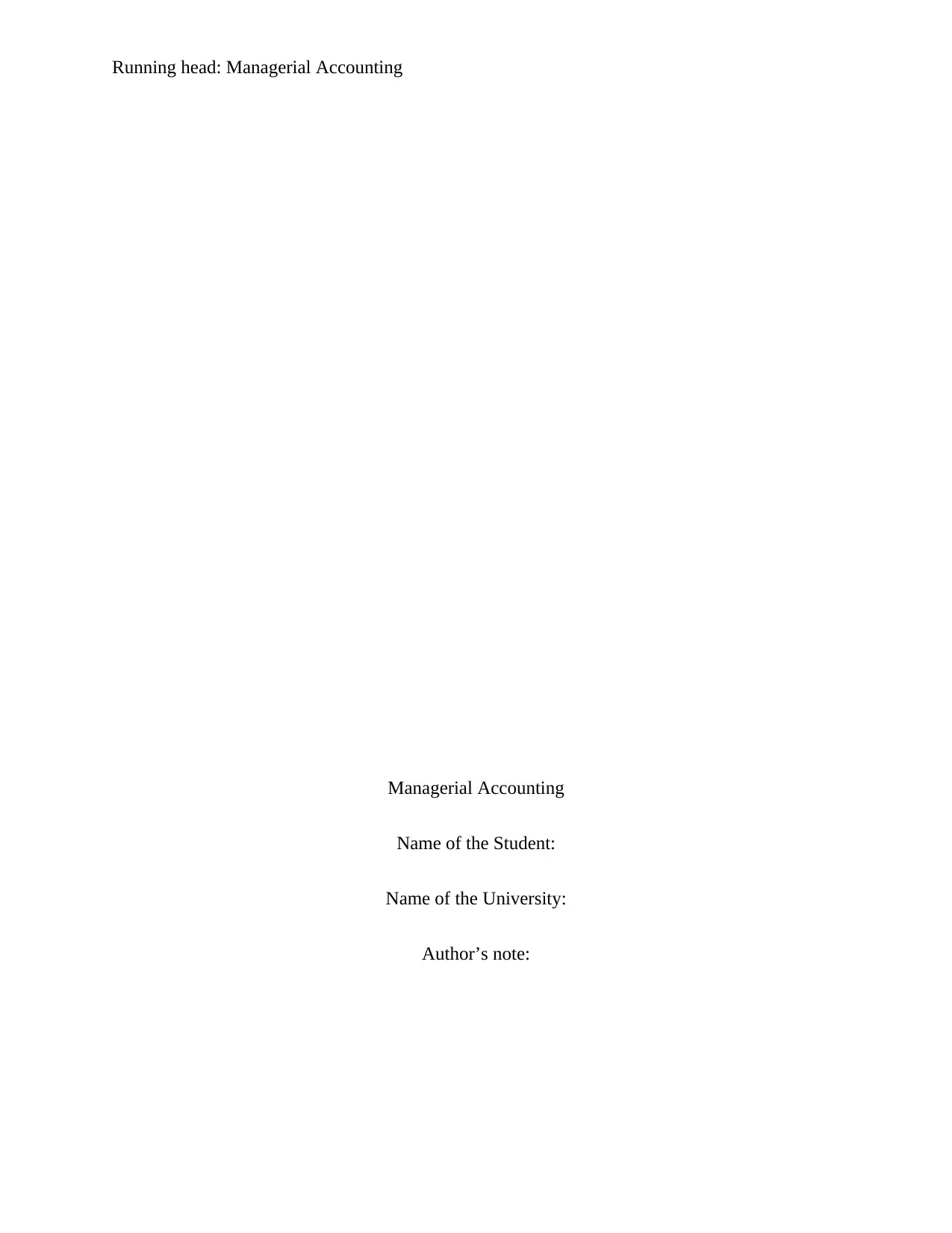
Running head: Managerial Accounting
Managerial Accounting
Name of the Student:
Name of the University:
Author’s note:
Managerial Accounting
Name of the Student:
Name of the University:
Author’s note:
Paraphrase This Document
Need a fresh take? Get an instant paraphrase of this document with our AI Paraphraser
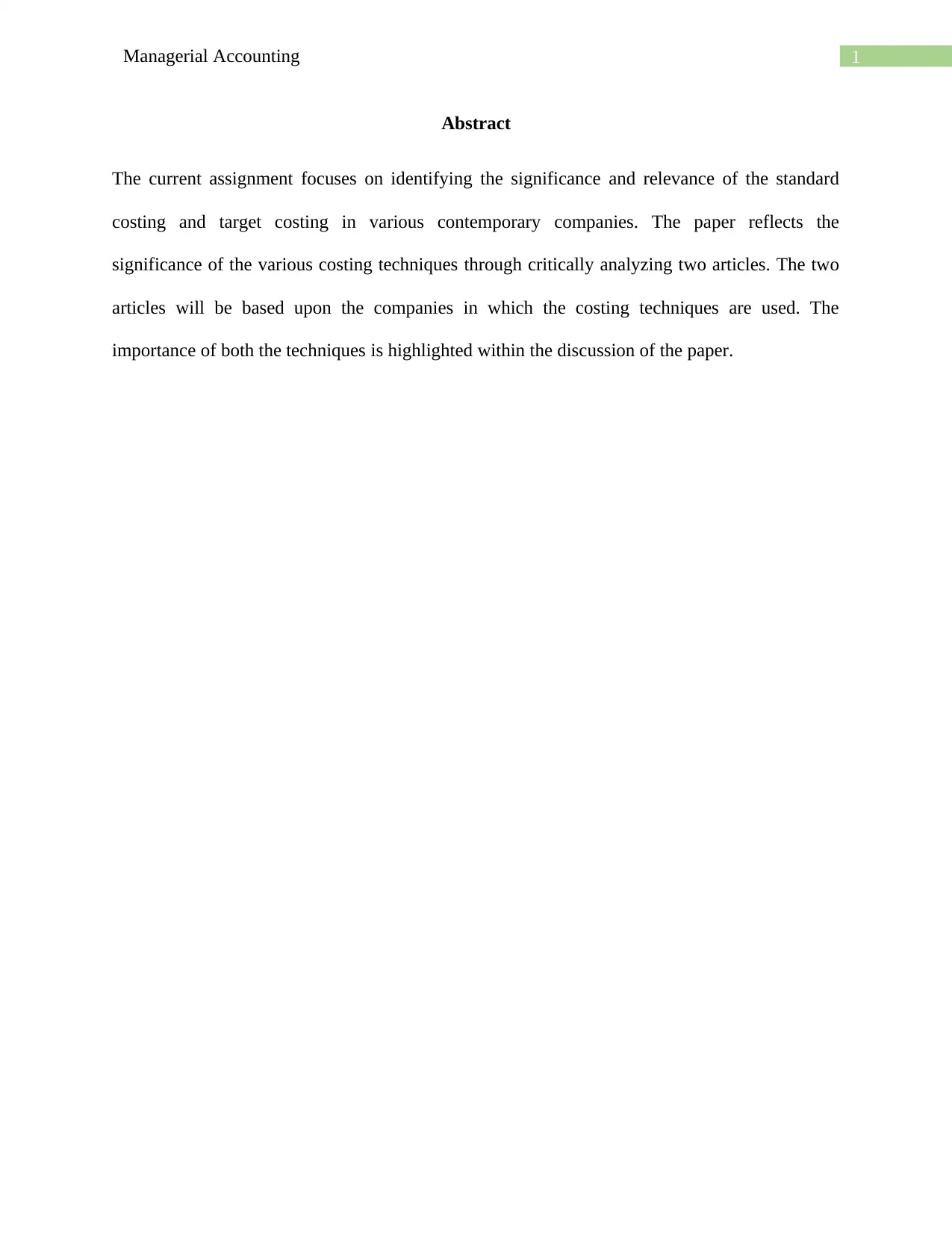
1Managerial Accounting
Abstract
The current assignment focuses on identifying the significance and relevance of the standard
costing and target costing in various contemporary companies. The paper reflects the
significance of the various costing techniques through critically analyzing two articles. The two
articles will be based upon the companies in which the costing techniques are used. The
importance of both the techniques is highlighted within the discussion of the paper.
Abstract
The current assignment focuses on identifying the significance and relevance of the standard
costing and target costing in various contemporary companies. The paper reflects the
significance of the various costing techniques through critically analyzing two articles. The two
articles will be based upon the companies in which the costing techniques are used. The
importance of both the techniques is highlighted within the discussion of the paper.
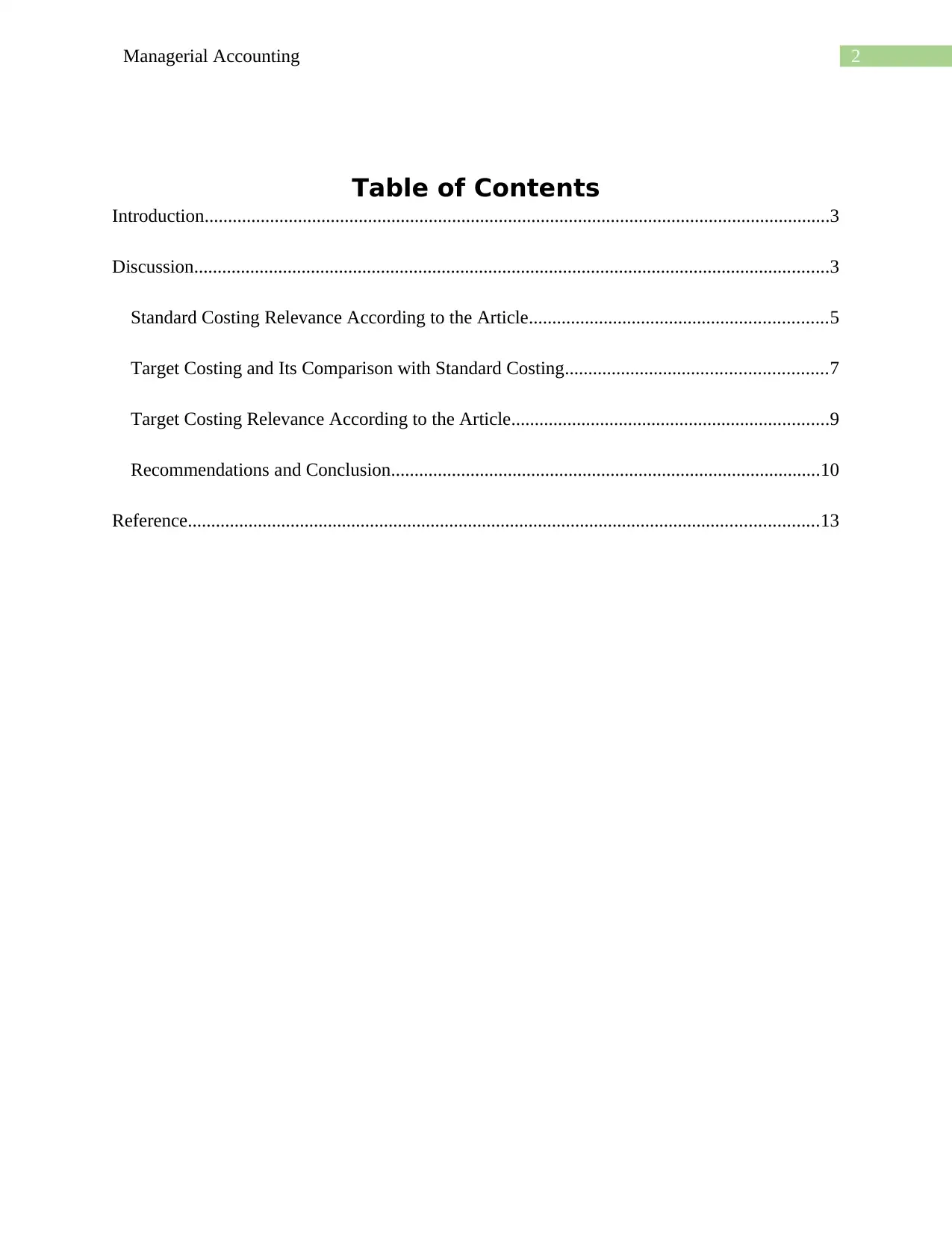
2Managerial Accounting
Table of Contents
Introduction......................................................................................................................................3
Discussion........................................................................................................................................3
Standard Costing Relevance According to the Article................................................................5
Target Costing and Its Comparison with Standard Costing........................................................7
Target Costing Relevance According to the Article....................................................................9
Recommendations and Conclusion............................................................................................10
Reference.......................................................................................................................................13
Table of Contents
Introduction......................................................................................................................................3
Discussion........................................................................................................................................3
Standard Costing Relevance According to the Article................................................................5
Target Costing and Its Comparison with Standard Costing........................................................7
Target Costing Relevance According to the Article....................................................................9
Recommendations and Conclusion............................................................................................10
Reference.......................................................................................................................................13
⊘ This is a preview!⊘
Do you want full access?
Subscribe today to unlock all pages.

Trusted by 1+ million students worldwide
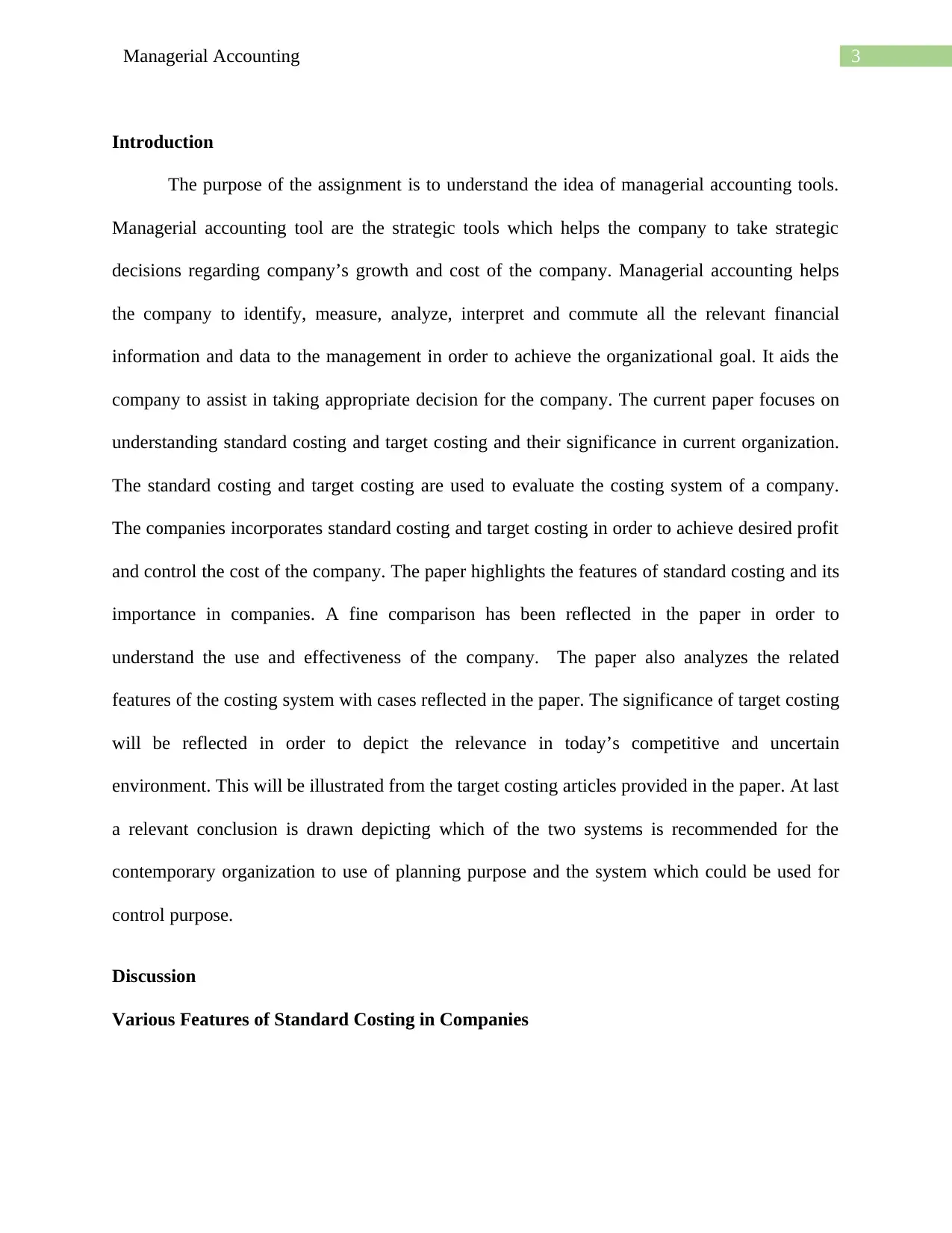
3Managerial Accounting
Introduction
The purpose of the assignment is to understand the idea of managerial accounting tools.
Managerial accounting tool are the strategic tools which helps the company to take strategic
decisions regarding company’s growth and cost of the company. Managerial accounting helps
the company to identify, measure, analyze, interpret and commute all the relevant financial
information and data to the management in order to achieve the organizational goal. It aids the
company to assist in taking appropriate decision for the company. The current paper focuses on
understanding standard costing and target costing and their significance in current organization.
The standard costing and target costing are used to evaluate the costing system of a company.
The companies incorporates standard costing and target costing in order to achieve desired profit
and control the cost of the company. The paper highlights the features of standard costing and its
importance in companies. A fine comparison has been reflected in the paper in order to
understand the use and effectiveness of the company. The paper also analyzes the related
features of the costing system with cases reflected in the paper. The significance of target costing
will be reflected in order to depict the relevance in today’s competitive and uncertain
environment. This will be illustrated from the target costing articles provided in the paper. At last
a relevant conclusion is drawn depicting which of the two systems is recommended for the
contemporary organization to use of planning purpose and the system which could be used for
control purpose.
Discussion
Various Features of Standard Costing in Companies
Introduction
The purpose of the assignment is to understand the idea of managerial accounting tools.
Managerial accounting tool are the strategic tools which helps the company to take strategic
decisions regarding company’s growth and cost of the company. Managerial accounting helps
the company to identify, measure, analyze, interpret and commute all the relevant financial
information and data to the management in order to achieve the organizational goal. It aids the
company to assist in taking appropriate decision for the company. The current paper focuses on
understanding standard costing and target costing and their significance in current organization.
The standard costing and target costing are used to evaluate the costing system of a company.
The companies incorporates standard costing and target costing in order to achieve desired profit
and control the cost of the company. The paper highlights the features of standard costing and its
importance in companies. A fine comparison has been reflected in the paper in order to
understand the use and effectiveness of the company. The paper also analyzes the related
features of the costing system with cases reflected in the paper. The significance of target costing
will be reflected in order to depict the relevance in today’s competitive and uncertain
environment. This will be illustrated from the target costing articles provided in the paper. At last
a relevant conclusion is drawn depicting which of the two systems is recommended for the
contemporary organization to use of planning purpose and the system which could be used for
control purpose.
Discussion
Various Features of Standard Costing in Companies
Paraphrase This Document
Need a fresh take? Get an instant paraphrase of this document with our AI Paraphraser
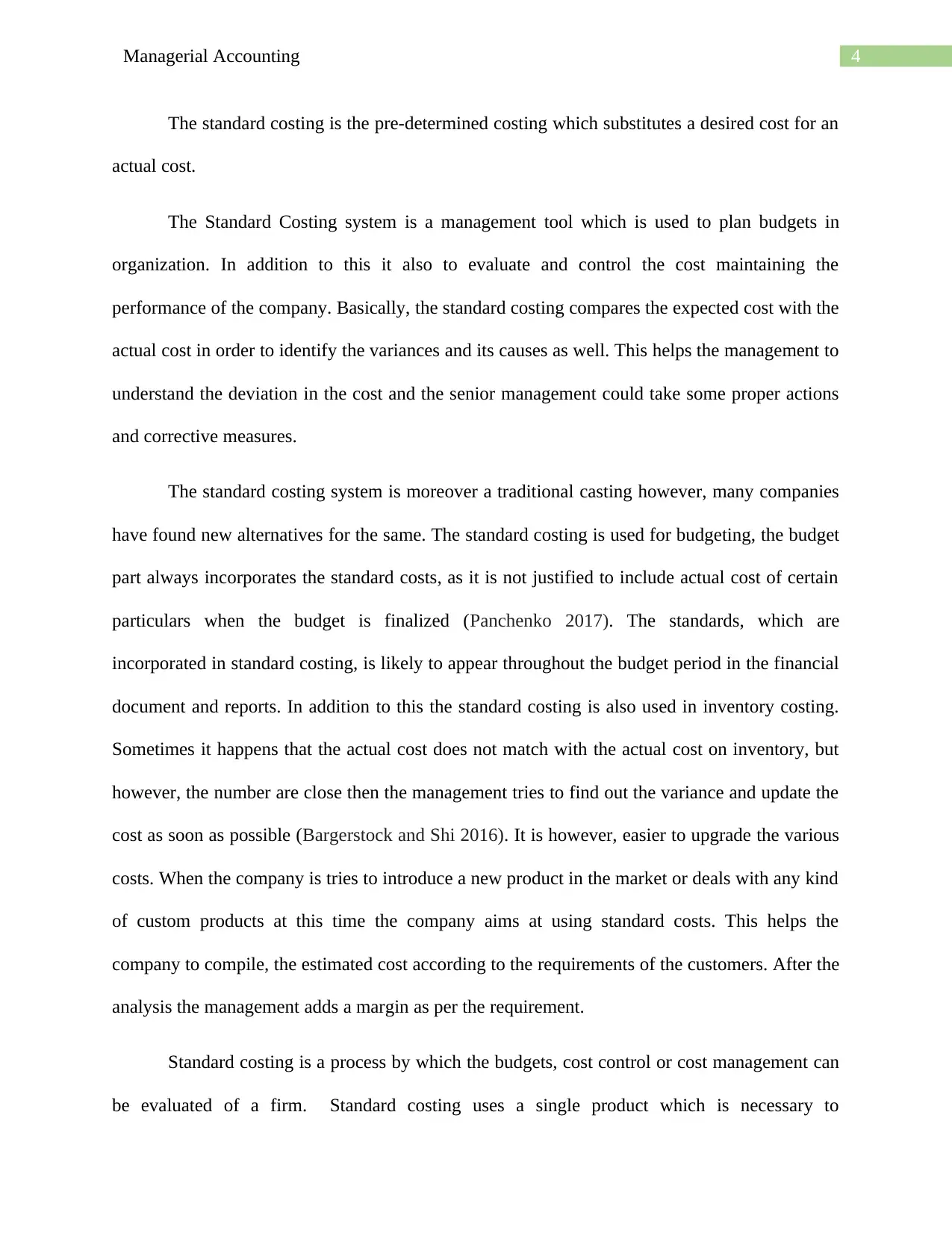
4Managerial Accounting
The standard costing is the pre-determined costing which substitutes a desired cost for an
actual cost.
The Standard Costing system is a management tool which is used to plan budgets in
organization. In addition to this it also to evaluate and control the cost maintaining the
performance of the company. Basically, the standard costing compares the expected cost with the
actual cost in order to identify the variances and its causes as well. This helps the management to
understand the deviation in the cost and the senior management could take some proper actions
and corrective measures.
The standard costing system is moreover a traditional casting however, many companies
have found new alternatives for the same. The standard costing is used for budgeting, the budget
part always incorporates the standard costs, as it is not justified to include actual cost of certain
particulars when the budget is finalized (Panchenko 2017). The standards, which are
incorporated in standard costing, is likely to appear throughout the budget period in the financial
document and reports. In addition to this the standard costing is also used in inventory costing.
Sometimes it happens that the actual cost does not match with the actual cost on inventory, but
however, the number are close then the management tries to find out the variance and update the
cost as soon as possible (Bargerstock and Shi 2016). It is however, easier to upgrade the various
costs. When the company is tries to introduce a new product in the market or deals with any kind
of custom products at this time the company aims at using standard costs. This helps the
company to compile, the estimated cost according to the requirements of the customers. After the
analysis the management adds a margin as per the requirement.
Standard costing is a process by which the budgets, cost control or cost management can
be evaluated of a firm. Standard costing uses a single product which is necessary to
The standard costing is the pre-determined costing which substitutes a desired cost for an
actual cost.
The Standard Costing system is a management tool which is used to plan budgets in
organization. In addition to this it also to evaluate and control the cost maintaining the
performance of the company. Basically, the standard costing compares the expected cost with the
actual cost in order to identify the variances and its causes as well. This helps the management to
understand the deviation in the cost and the senior management could take some proper actions
and corrective measures.
The standard costing system is moreover a traditional casting however, many companies
have found new alternatives for the same. The standard costing is used for budgeting, the budget
part always incorporates the standard costs, as it is not justified to include actual cost of certain
particulars when the budget is finalized (Panchenko 2017). The standards, which are
incorporated in standard costing, is likely to appear throughout the budget period in the financial
document and reports. In addition to this the standard costing is also used in inventory costing.
Sometimes it happens that the actual cost does not match with the actual cost on inventory, but
however, the number are close then the management tries to find out the variance and update the
cost as soon as possible (Bargerstock and Shi 2016). It is however, easier to upgrade the various
costs. When the company is tries to introduce a new product in the market or deals with any kind
of custom products at this time the company aims at using standard costs. This helps the
company to compile, the estimated cost according to the requirements of the customers. After the
analysis the management adds a margin as per the requirement.
Standard costing is a process by which the budgets, cost control or cost management can
be evaluated of a firm. Standard costing uses a single product which is necessary to
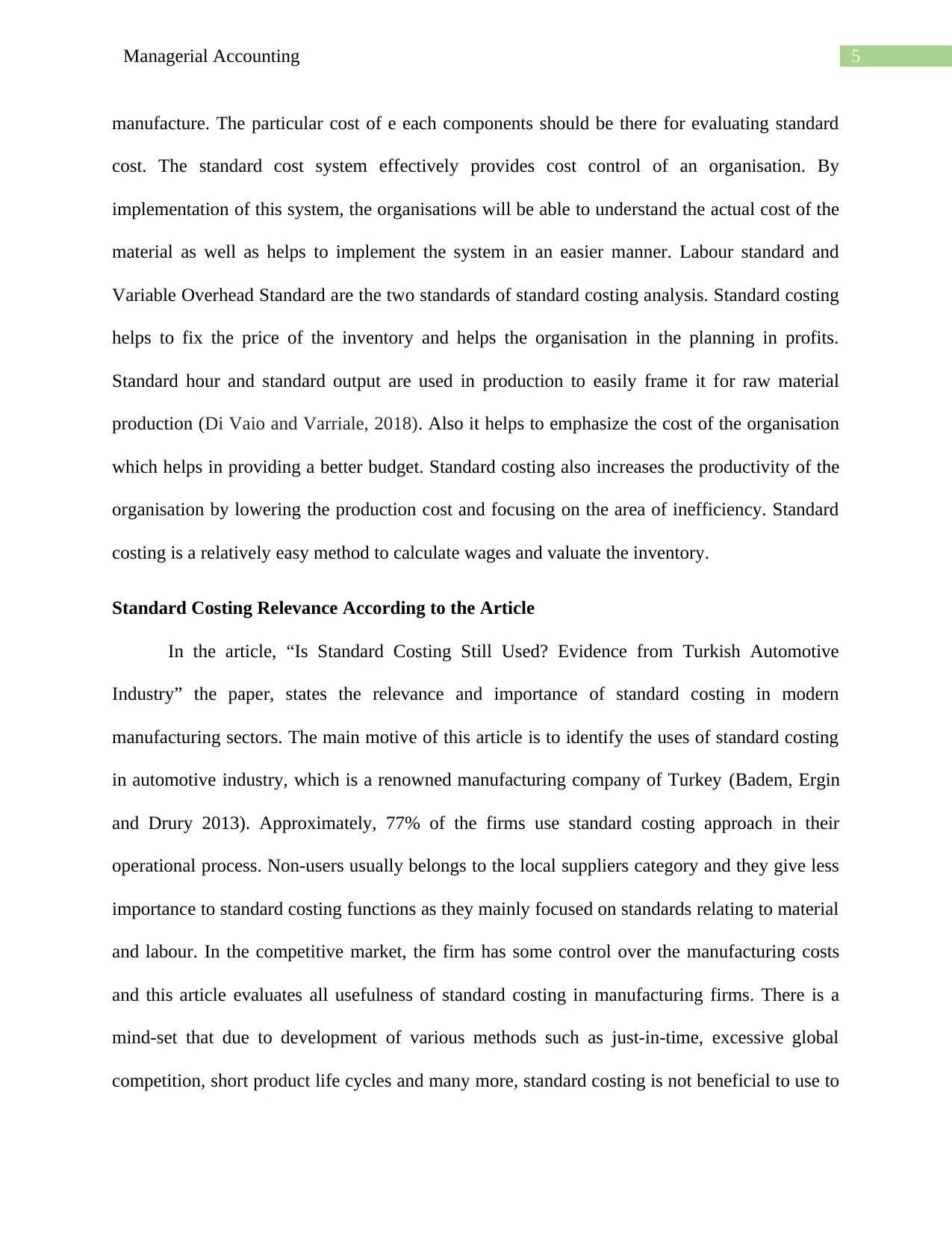
5Managerial Accounting
manufacture. The particular cost of e each components should be there for evaluating standard
cost. The standard cost system effectively provides cost control of an organisation. By
implementation of this system, the organisations will be able to understand the actual cost of the
material as well as helps to implement the system in an easier manner. Labour standard and
Variable Overhead Standard are the two standards of standard costing analysis. Standard costing
helps to fix the price of the inventory and helps the organisation in the planning in profits.
Standard hour and standard output are used in production to easily frame it for raw material
production (Di Vaio and Varriale, 2018). Also it helps to emphasize the cost of the organisation
which helps in providing a better budget. Standard costing also increases the productivity of the
organisation by lowering the production cost and focusing on the area of inefficiency. Standard
costing is a relatively easy method to calculate wages and valuate the inventory.
Standard Costing Relevance According to the Article
In the article, “Is Standard Costing Still Used? Evidence from Turkish Automotive
Industry” the paper, states the relevance and importance of standard costing in modern
manufacturing sectors. The main motive of this article is to identify the uses of standard costing
in automotive industry, which is a renowned manufacturing company of Turkey (Badem, Ergin
and Drury 2013). Approximately, 77% of the firms use standard costing approach in their
operational process. Non-users usually belongs to the local suppliers category and they give less
importance to standard costing functions as they mainly focused on standards relating to material
and labour. In the competitive market, the firm has some control over the manufacturing costs
and this article evaluates all usefulness of standard costing in manufacturing firms. There is a
mind-set that due to development of various methods such as just-in-time, excessive global
competition, short product life cycles and many more, standard costing is not beneficial to use to
manufacture. The particular cost of e each components should be there for evaluating standard
cost. The standard cost system effectively provides cost control of an organisation. By
implementation of this system, the organisations will be able to understand the actual cost of the
material as well as helps to implement the system in an easier manner. Labour standard and
Variable Overhead Standard are the two standards of standard costing analysis. Standard costing
helps to fix the price of the inventory and helps the organisation in the planning in profits.
Standard hour and standard output are used in production to easily frame it for raw material
production (Di Vaio and Varriale, 2018). Also it helps to emphasize the cost of the organisation
which helps in providing a better budget. Standard costing also increases the productivity of the
organisation by lowering the production cost and focusing on the area of inefficiency. Standard
costing is a relatively easy method to calculate wages and valuate the inventory.
Standard Costing Relevance According to the Article
In the article, “Is Standard Costing Still Used? Evidence from Turkish Automotive
Industry” the paper, states the relevance and importance of standard costing in modern
manufacturing sectors. The main motive of this article is to identify the uses of standard costing
in automotive industry, which is a renowned manufacturing company of Turkey (Badem, Ergin
and Drury 2013). Approximately, 77% of the firms use standard costing approach in their
operational process. Non-users usually belongs to the local suppliers category and they give less
importance to standard costing functions as they mainly focused on standards relating to material
and labour. In the competitive market, the firm has some control over the manufacturing costs
and this article evaluates all usefulness of standard costing in manufacturing firms. There is a
mind-set that due to development of various methods such as just-in-time, excessive global
competition, short product life cycles and many more, standard costing is not beneficial to use to
⊘ This is a preview!⊘
Do you want full access?
Subscribe today to unlock all pages.

Trusted by 1+ million students worldwide
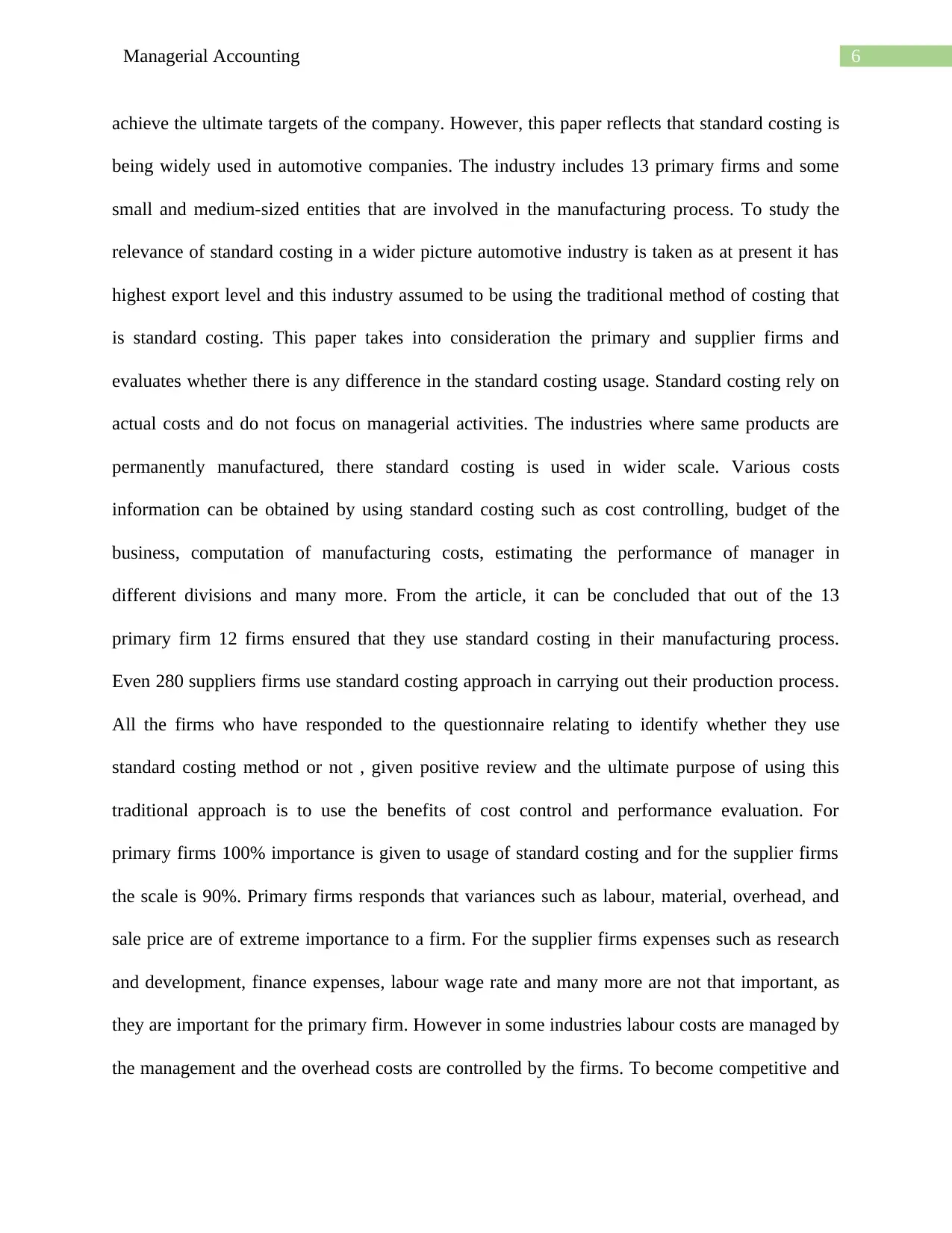
6Managerial Accounting
achieve the ultimate targets of the company. However, this paper reflects that standard costing is
being widely used in automotive companies. The industry includes 13 primary firms and some
small and medium-sized entities that are involved in the manufacturing process. To study the
relevance of standard costing in a wider picture automotive industry is taken as at present it has
highest export level and this industry assumed to be using the traditional method of costing that
is standard costing. This paper takes into consideration the primary and supplier firms and
evaluates whether there is any difference in the standard costing usage. Standard costing rely on
actual costs and do not focus on managerial activities. The industries where same products are
permanently manufactured, there standard costing is used in wider scale. Various costs
information can be obtained by using standard costing such as cost controlling, budget of the
business, computation of manufacturing costs, estimating the performance of manager in
different divisions and many more. From the article, it can be concluded that out of the 13
primary firm 12 firms ensured that they use standard costing in their manufacturing process.
Even 280 suppliers firms use standard costing approach in carrying out their production process.
All the firms who have responded to the questionnaire relating to identify whether they use
standard costing method or not , given positive review and the ultimate purpose of using this
traditional approach is to use the benefits of cost control and performance evaluation. For
primary firms 100% importance is given to usage of standard costing and for the supplier firms
the scale is 90%. Primary firms responds that variances such as labour, material, overhead, and
sale price are of extreme importance to a firm. For the supplier firms expenses such as research
and development, finance expenses, labour wage rate and many more are not that important, as
they are important for the primary firm. However in some industries labour costs are managed by
the management and the overhead costs are controlled by the firms. To become competitive and
achieve the ultimate targets of the company. However, this paper reflects that standard costing is
being widely used in automotive companies. The industry includes 13 primary firms and some
small and medium-sized entities that are involved in the manufacturing process. To study the
relevance of standard costing in a wider picture automotive industry is taken as at present it has
highest export level and this industry assumed to be using the traditional method of costing that
is standard costing. This paper takes into consideration the primary and supplier firms and
evaluates whether there is any difference in the standard costing usage. Standard costing rely on
actual costs and do not focus on managerial activities. The industries where same products are
permanently manufactured, there standard costing is used in wider scale. Various costs
information can be obtained by using standard costing such as cost controlling, budget of the
business, computation of manufacturing costs, estimating the performance of manager in
different divisions and many more. From the article, it can be concluded that out of the 13
primary firm 12 firms ensured that they use standard costing in their manufacturing process.
Even 280 suppliers firms use standard costing approach in carrying out their production process.
All the firms who have responded to the questionnaire relating to identify whether they use
standard costing method or not , given positive review and the ultimate purpose of using this
traditional approach is to use the benefits of cost control and performance evaluation. For
primary firms 100% importance is given to usage of standard costing and for the supplier firms
the scale is 90%. Primary firms responds that variances such as labour, material, overhead, and
sale price are of extreme importance to a firm. For the supplier firms expenses such as research
and development, finance expenses, labour wage rate and many more are not that important, as
they are important for the primary firm. However in some industries labour costs are managed by
the management and the overhead costs are controlled by the firms. To become competitive and
Paraphrase This Document
Need a fresh take? Get an instant paraphrase of this document with our AI Paraphraser
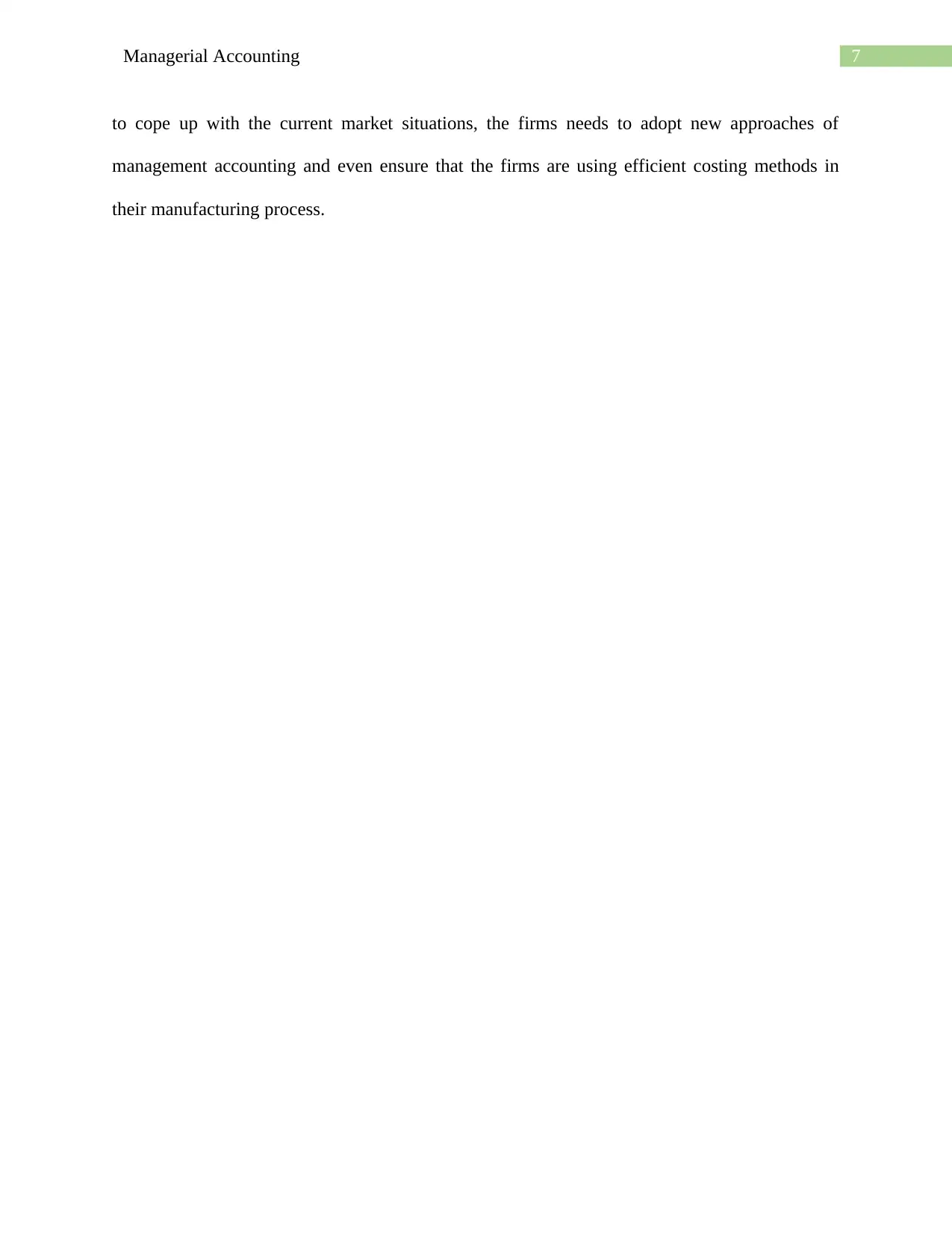
7Managerial Accounting
to cope up with the current market situations, the firms needs to adopt new approaches of
management accounting and even ensure that the firms are using efficient costing methods in
their manufacturing process.
to cope up with the current market situations, the firms needs to adopt new approaches of
management accounting and even ensure that the firms are using efficient costing methods in
their manufacturing process.
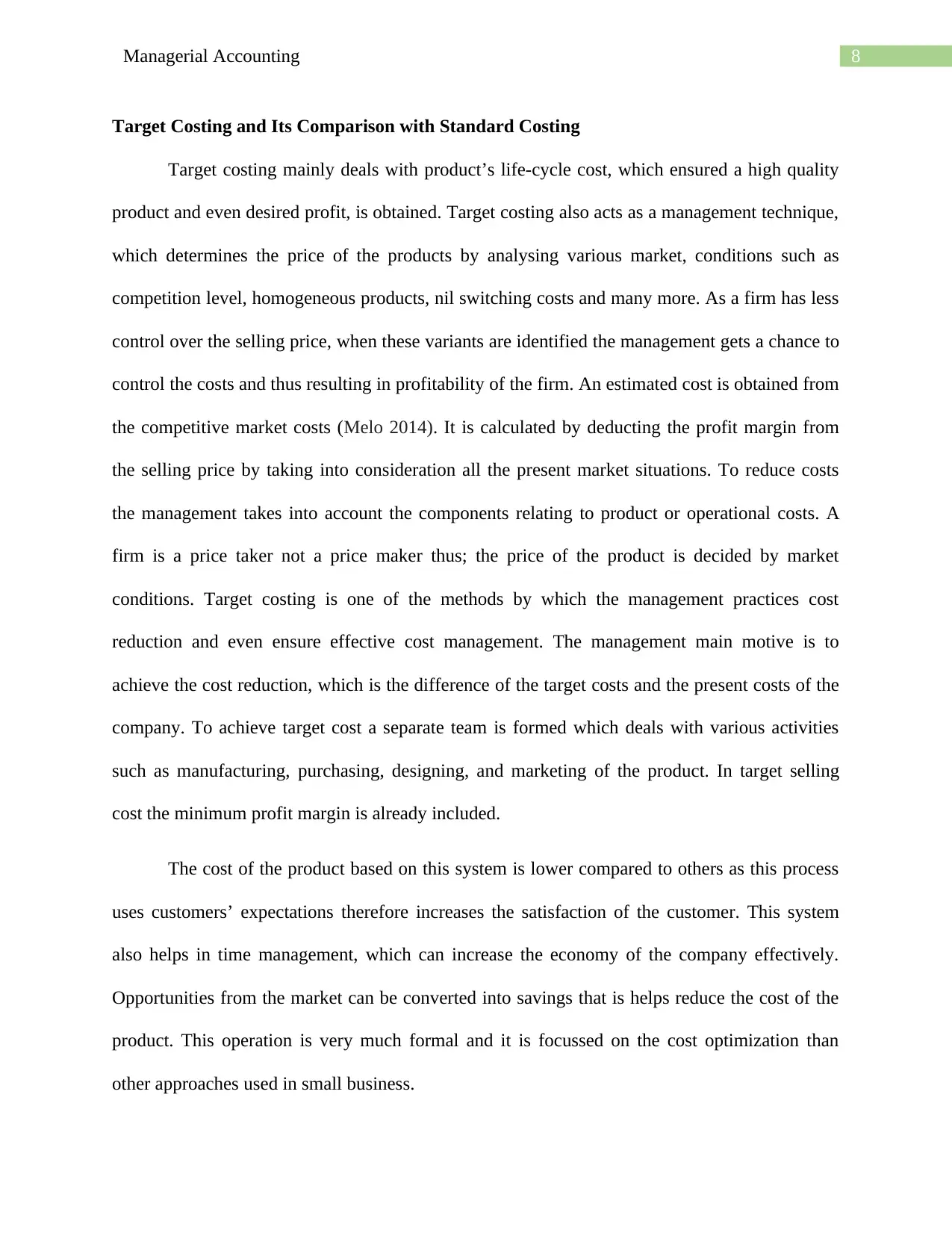
8Managerial Accounting
Target Costing and Its Comparison with Standard Costing
Target costing mainly deals with product’s life-cycle cost, which ensured a high quality
product and even desired profit, is obtained. Target costing also acts as a management technique,
which determines the price of the products by analysing various market, conditions such as
competition level, homogeneous products, nil switching costs and many more. As a firm has less
control over the selling price, when these variants are identified the management gets a chance to
control the costs and thus resulting in profitability of the firm. An estimated cost is obtained from
the competitive market costs (Melo 2014). It is calculated by deducting the profit margin from
the selling price by taking into consideration all the present market situations. To reduce costs
the management takes into account the components relating to product or operational costs. A
firm is a price taker not a price maker thus; the price of the product is decided by market
conditions. Target costing is one of the methods by which the management practices cost
reduction and even ensure effective cost management. The management main motive is to
achieve the cost reduction, which is the difference of the target costs and the present costs of the
company. To achieve target cost a separate team is formed which deals with various activities
such as manufacturing, purchasing, designing, and marketing of the product. In target selling
cost the minimum profit margin is already included.
The cost of the product based on this system is lower compared to others as this process
uses customers’ expectations therefore increases the satisfaction of the customer. This system
also helps in time management, which can increase the economy of the company effectively.
Opportunities from the market can be converted into savings that is helps reduce the cost of the
product. This operation is very much formal and it is focussed on the cost optimization than
other approaches used in small business.
Target Costing and Its Comparison with Standard Costing
Target costing mainly deals with product’s life-cycle cost, which ensured a high quality
product and even desired profit, is obtained. Target costing also acts as a management technique,
which determines the price of the products by analysing various market, conditions such as
competition level, homogeneous products, nil switching costs and many more. As a firm has less
control over the selling price, when these variants are identified the management gets a chance to
control the costs and thus resulting in profitability of the firm. An estimated cost is obtained from
the competitive market costs (Melo 2014). It is calculated by deducting the profit margin from
the selling price by taking into consideration all the present market situations. To reduce costs
the management takes into account the components relating to product or operational costs. A
firm is a price taker not a price maker thus; the price of the product is decided by market
conditions. Target costing is one of the methods by which the management practices cost
reduction and even ensure effective cost management. The management main motive is to
achieve the cost reduction, which is the difference of the target costs and the present costs of the
company. To achieve target cost a separate team is formed which deals with various activities
such as manufacturing, purchasing, designing, and marketing of the product. In target selling
cost the minimum profit margin is already included.
The cost of the product based on this system is lower compared to others as this process
uses customers’ expectations therefore increases the satisfaction of the customer. This system
also helps in time management, which can increase the economy of the company effectively.
Opportunities from the market can be converted into savings that is helps reduce the cost of the
product. This operation is very much formal and it is focussed on the cost optimization than
other approaches used in small business.
⊘ This is a preview!⊘
Do you want full access?
Subscribe today to unlock all pages.

Trusted by 1+ million students worldwide
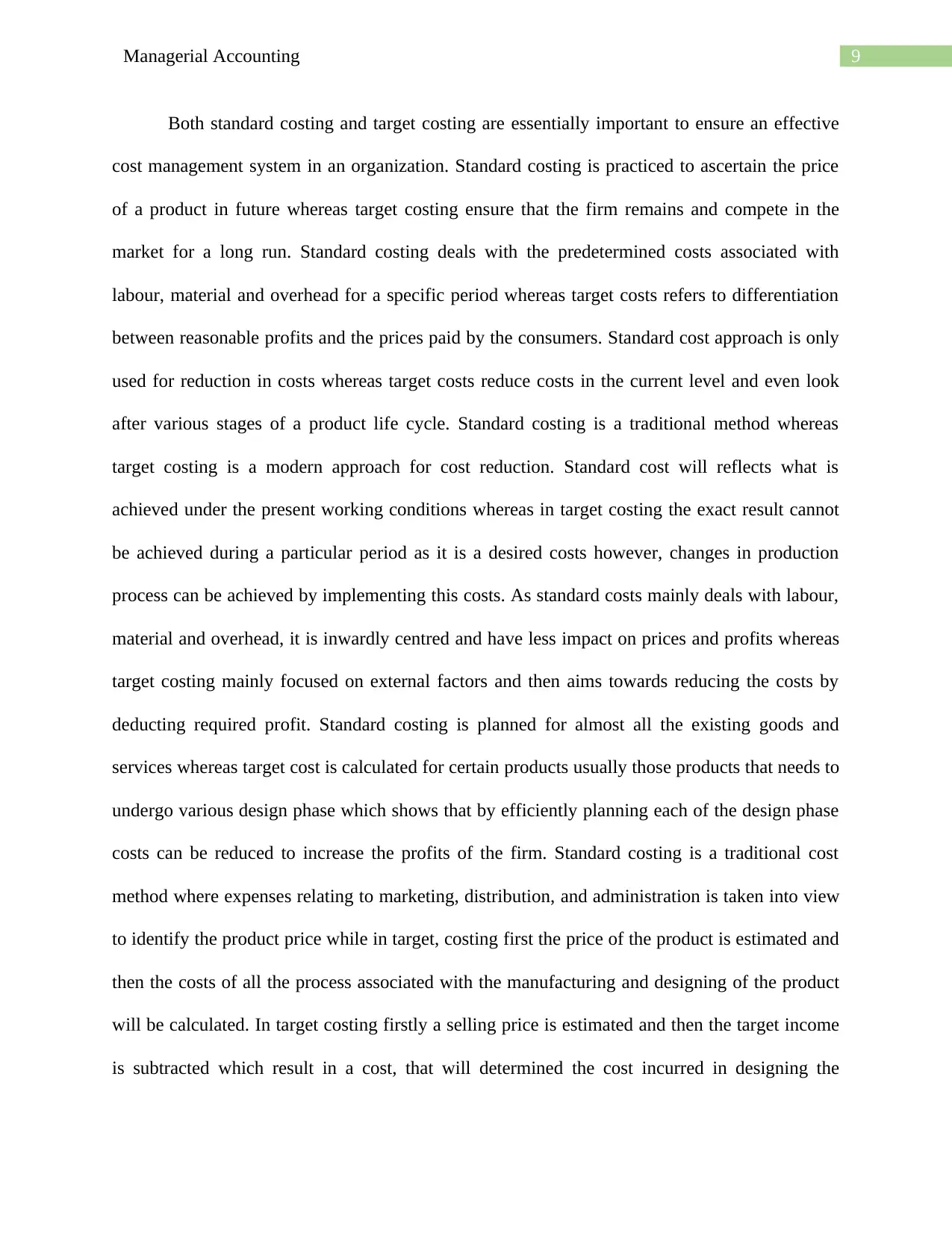
9Managerial Accounting
Both standard costing and target costing are essentially important to ensure an effective
cost management system in an organization. Standard costing is practiced to ascertain the price
of a product in future whereas target costing ensure that the firm remains and compete in the
market for a long run. Standard costing deals with the predetermined costs associated with
labour, material and overhead for a specific period whereas target costs refers to differentiation
between reasonable profits and the prices paid by the consumers. Standard cost approach is only
used for reduction in costs whereas target costs reduce costs in the current level and even look
after various stages of a product life cycle. Standard costing is a traditional method whereas
target costing is a modern approach for cost reduction. Standard cost will reflects what is
achieved under the present working conditions whereas in target costing the exact result cannot
be achieved during a particular period as it is a desired costs however, changes in production
process can be achieved by implementing this costs. As standard costs mainly deals with labour,
material and overhead, it is inwardly centred and have less impact on prices and profits whereas
target costing mainly focused on external factors and then aims towards reducing the costs by
deducting required profit. Standard costing is planned for almost all the existing goods and
services whereas target cost is calculated for certain products usually those products that needs to
undergo various design phase which shows that by efficiently planning each of the design phase
costs can be reduced to increase the profits of the firm. Standard costing is a traditional cost
method where expenses relating to marketing, distribution, and administration is taken into view
to identify the product price while in target, costing first the price of the product is estimated and
then the costs of all the process associated with the manufacturing and designing of the product
will be calculated. In target costing firstly a selling price is estimated and then the target income
is subtracted which result in a cost, that will determined the cost incurred in designing the
Both standard costing and target costing are essentially important to ensure an effective
cost management system in an organization. Standard costing is practiced to ascertain the price
of a product in future whereas target costing ensure that the firm remains and compete in the
market for a long run. Standard costing deals with the predetermined costs associated with
labour, material and overhead for a specific period whereas target costs refers to differentiation
between reasonable profits and the prices paid by the consumers. Standard cost approach is only
used for reduction in costs whereas target costs reduce costs in the current level and even look
after various stages of a product life cycle. Standard costing is a traditional method whereas
target costing is a modern approach for cost reduction. Standard cost will reflects what is
achieved under the present working conditions whereas in target costing the exact result cannot
be achieved during a particular period as it is a desired costs however, changes in production
process can be achieved by implementing this costs. As standard costs mainly deals with labour,
material and overhead, it is inwardly centred and have less impact on prices and profits whereas
target costing mainly focused on external factors and then aims towards reducing the costs by
deducting required profit. Standard costing is planned for almost all the existing goods and
services whereas target cost is calculated for certain products usually those products that needs to
undergo various design phase which shows that by efficiently planning each of the design phase
costs can be reduced to increase the profits of the firm. Standard costing is a traditional cost
method where expenses relating to marketing, distribution, and administration is taken into view
to identify the product price while in target, costing first the price of the product is estimated and
then the costs of all the process associated with the manufacturing and designing of the product
will be calculated. In target costing firstly a selling price is estimated and then the target income
is subtracted which result in a cost, that will determined the cost incurred in designing the
Paraphrase This Document
Need a fresh take? Get an instant paraphrase of this document with our AI Paraphraser
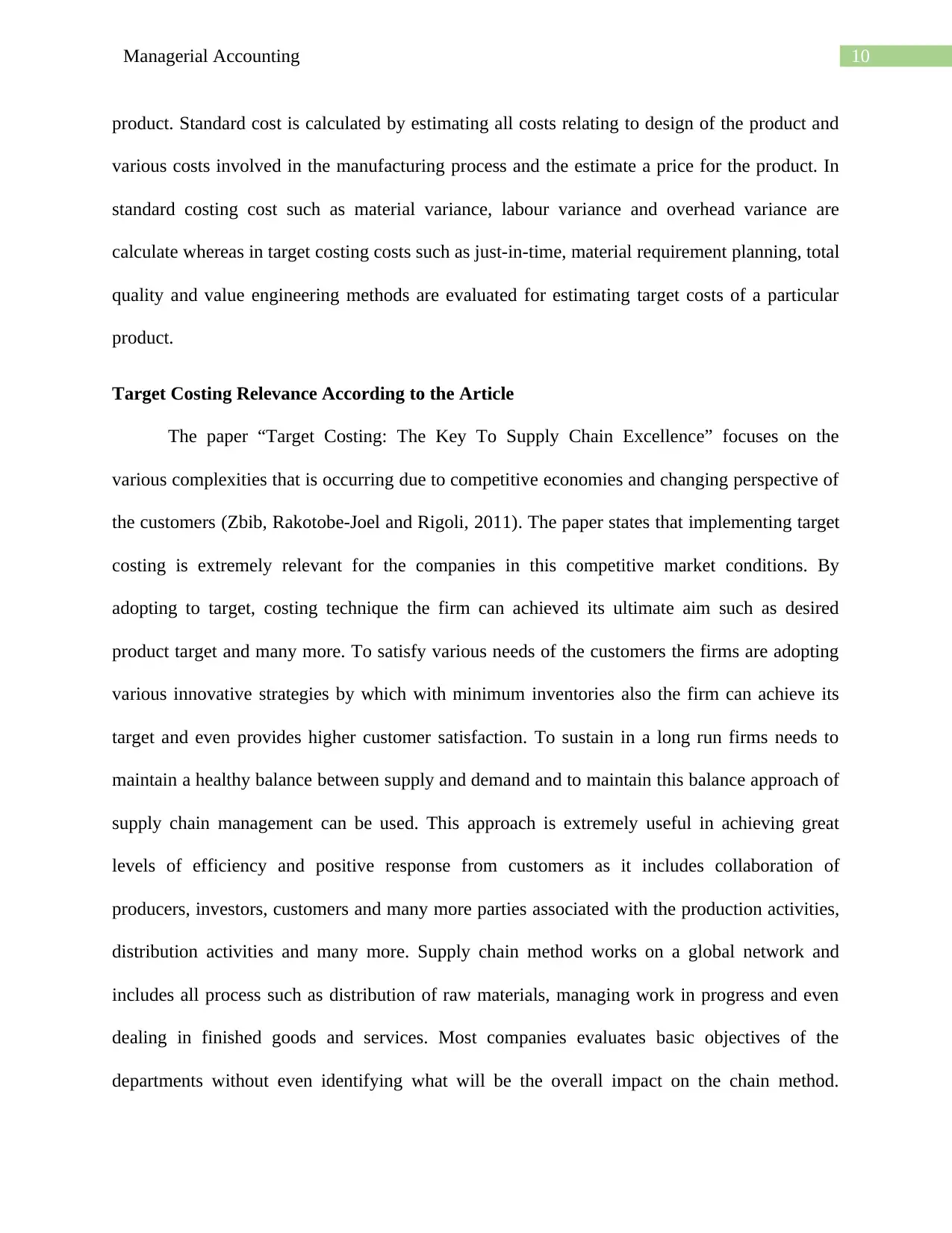
10Managerial Accounting
product. Standard cost is calculated by estimating all costs relating to design of the product and
various costs involved in the manufacturing process and the estimate a price for the product. In
standard costing cost such as material variance, labour variance and overhead variance are
calculate whereas in target costing costs such as just-in-time, material requirement planning, total
quality and value engineering methods are evaluated for estimating target costs of a particular
product.
Target Costing Relevance According to the Article
The paper “Target Costing: The Key To Supply Chain Excellence” focuses on the
various complexities that is occurring due to competitive economies and changing perspective of
the customers (Zbib, Rakotobe-Joel and Rigoli, 2011). The paper states that implementing target
costing is extremely relevant for the companies in this competitive market conditions. By
adopting to target, costing technique the firm can achieved its ultimate aim such as desired
product target and many more. To satisfy various needs of the customers the firms are adopting
various innovative strategies by which with minimum inventories also the firm can achieve its
target and even provides higher customer satisfaction. To sustain in a long run firms needs to
maintain a healthy balance between supply and demand and to maintain this balance approach of
supply chain management can be used. This approach is extremely useful in achieving great
levels of efficiency and positive response from customers as it includes collaboration of
producers, investors, customers and many more parties associated with the production activities,
distribution activities and many more. Supply chain method works on a global network and
includes all process such as distribution of raw materials, managing work in progress and even
dealing in finished goods and services. Most companies evaluates basic objectives of the
departments without even identifying what will be the overall impact on the chain method.
product. Standard cost is calculated by estimating all costs relating to design of the product and
various costs involved in the manufacturing process and the estimate a price for the product. In
standard costing cost such as material variance, labour variance and overhead variance are
calculate whereas in target costing costs such as just-in-time, material requirement planning, total
quality and value engineering methods are evaluated for estimating target costs of a particular
product.
Target Costing Relevance According to the Article
The paper “Target Costing: The Key To Supply Chain Excellence” focuses on the
various complexities that is occurring due to competitive economies and changing perspective of
the customers (Zbib, Rakotobe-Joel and Rigoli, 2011). The paper states that implementing target
costing is extremely relevant for the companies in this competitive market conditions. By
adopting to target, costing technique the firm can achieved its ultimate aim such as desired
product target and many more. To satisfy various needs of the customers the firms are adopting
various innovative strategies by which with minimum inventories also the firm can achieve its
target and even provides higher customer satisfaction. To sustain in a long run firms needs to
maintain a healthy balance between supply and demand and to maintain this balance approach of
supply chain management can be used. This approach is extremely useful in achieving great
levels of efficiency and positive response from customers as it includes collaboration of
producers, investors, customers and many more parties associated with the production activities,
distribution activities and many more. Supply chain method works on a global network and
includes all process such as distribution of raw materials, managing work in progress and even
dealing in finished goods and services. Most companies evaluates basic objectives of the
departments without even identifying what will be the overall impact on the chain method.
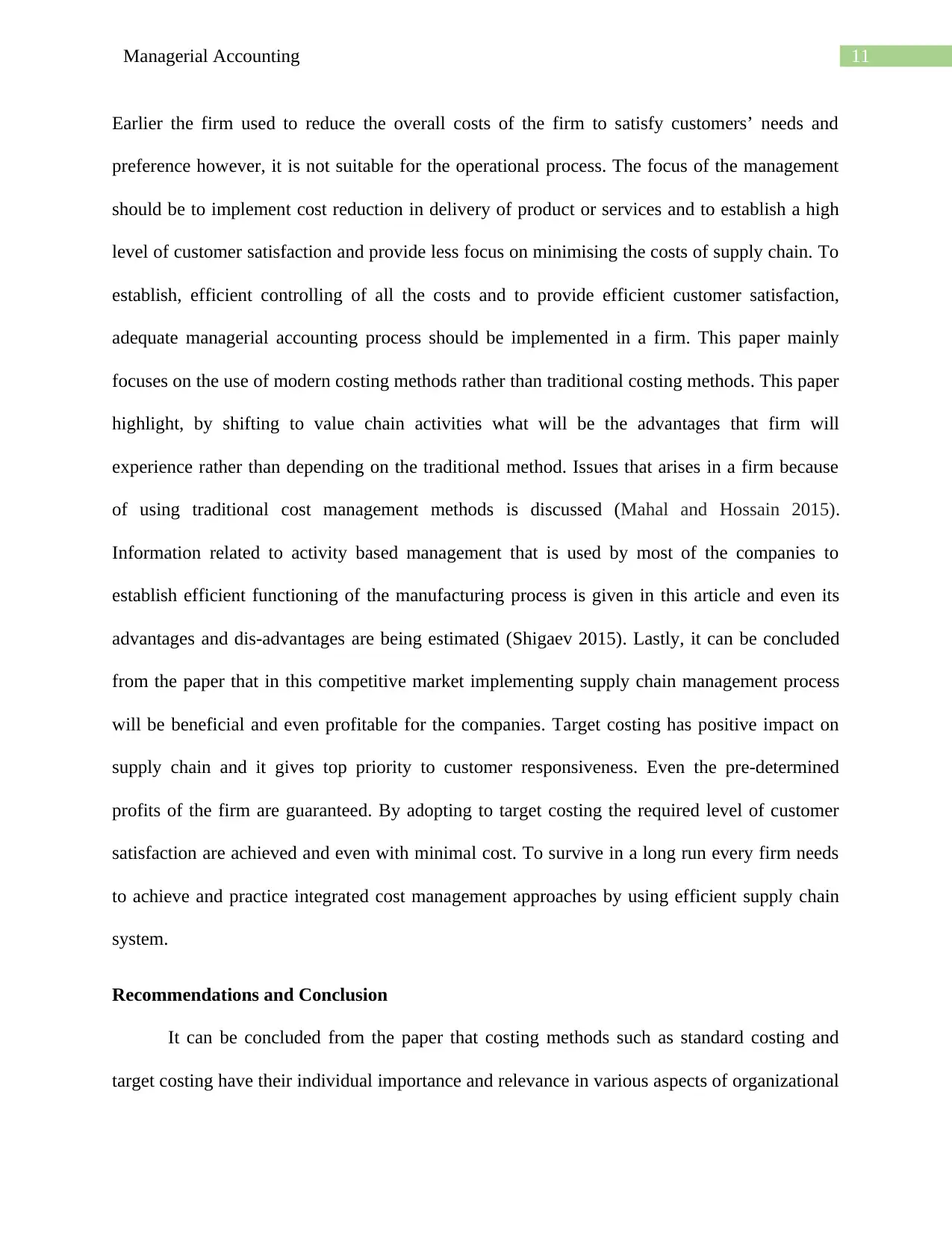
11Managerial Accounting
Earlier the firm used to reduce the overall costs of the firm to satisfy customers’ needs and
preference however, it is not suitable for the operational process. The focus of the management
should be to implement cost reduction in delivery of product or services and to establish a high
level of customer satisfaction and provide less focus on minimising the costs of supply chain. To
establish, efficient controlling of all the costs and to provide efficient customer satisfaction,
adequate managerial accounting process should be implemented in a firm. This paper mainly
focuses on the use of modern costing methods rather than traditional costing methods. This paper
highlight, by shifting to value chain activities what will be the advantages that firm will
experience rather than depending on the traditional method. Issues that arises in a firm because
of using traditional cost management methods is discussed (Mahal and Hossain 2015).
Information related to activity based management that is used by most of the companies to
establish efficient functioning of the manufacturing process is given in this article and even its
advantages and dis-advantages are being estimated (Shigaev 2015). Lastly, it can be concluded
from the paper that in this competitive market implementing supply chain management process
will be beneficial and even profitable for the companies. Target costing has positive impact on
supply chain and it gives top priority to customer responsiveness. Even the pre-determined
profits of the firm are guaranteed. By adopting to target costing the required level of customer
satisfaction are achieved and even with minimal cost. To survive in a long run every firm needs
to achieve and practice integrated cost management approaches by using efficient supply chain
system.
Recommendations and Conclusion
It can be concluded from the paper that costing methods such as standard costing and
target costing have their individual importance and relevance in various aspects of organizational
Earlier the firm used to reduce the overall costs of the firm to satisfy customers’ needs and
preference however, it is not suitable for the operational process. The focus of the management
should be to implement cost reduction in delivery of product or services and to establish a high
level of customer satisfaction and provide less focus on minimising the costs of supply chain. To
establish, efficient controlling of all the costs and to provide efficient customer satisfaction,
adequate managerial accounting process should be implemented in a firm. This paper mainly
focuses on the use of modern costing methods rather than traditional costing methods. This paper
highlight, by shifting to value chain activities what will be the advantages that firm will
experience rather than depending on the traditional method. Issues that arises in a firm because
of using traditional cost management methods is discussed (Mahal and Hossain 2015).
Information related to activity based management that is used by most of the companies to
establish efficient functioning of the manufacturing process is given in this article and even its
advantages and dis-advantages are being estimated (Shigaev 2015). Lastly, it can be concluded
from the paper that in this competitive market implementing supply chain management process
will be beneficial and even profitable for the companies. Target costing has positive impact on
supply chain and it gives top priority to customer responsiveness. Even the pre-determined
profits of the firm are guaranteed. By adopting to target costing the required level of customer
satisfaction are achieved and even with minimal cost. To survive in a long run every firm needs
to achieve and practice integrated cost management approaches by using efficient supply chain
system.
Recommendations and Conclusion
It can be concluded from the paper that costing methods such as standard costing and
target costing have their individual importance and relevance in various aspects of organizational
⊘ This is a preview!⊘
Do you want full access?
Subscribe today to unlock all pages.

Trusted by 1+ million students worldwide
1 out of 17
Related Documents
Your All-in-One AI-Powered Toolkit for Academic Success.
+13062052269
info@desklib.com
Available 24*7 on WhatsApp / Email
![[object Object]](/_next/static/media/star-bottom.7253800d.svg)
Unlock your academic potential
Copyright © 2020–2025 A2Z Services. All Rights Reserved. Developed and managed by ZUCOL.





